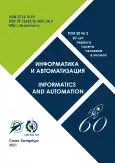In modern conditions, in the field of the creation and use of existing and advanced space vehicles (SV), the issues of autonomy and survivability acquire particular relevance in the development and operation of small-mass spacecraft (SMS) for Earth remote sensing (ERS). The specificity of the small spacecraft lies in the fact that it is difficult to directly apply to the process of their creation the standard practice of using the system for ensuring the reliability of the rocket and space industry due to the lack of the ability to provide full structural redundancy of its onboard systems (OBS) associated with mass-dimensional and other restrictions. In this case, the tasks of developing model-algorithmic methods and approaches to ensuring the required level of indicators of structural reliability, survivability and, in general, the effectiveness of the functioning of the MCA OBS become of particular relevance. The problem of increasing the level of indicators of autonomy, survivability, efficiency of functioning of complex technical objects (CTO), which, in particular, SMS belong, is considered in the scientific literature in conjunction with solving problems of control, assessment and technical diagnostics of the state of the CTO reconfiguration (structural, functional, structural-functional reconfiguration) of CTO structures, management of its reserves, alternative and multi-mode control, analysis of fault tolerance and disaster recovery of CTO. However, all of these studies are fragmented, both at the methodological and methodological and technological levels. The article provides a generalized description of the combined methods and algorithms developed by the authors for solving the problems of synthesis of technologies and programs for controlling the OS reconfiguration to increase the survivability of the SMS. At the same time, these tasks are solved not in isolation, but in a comprehensive manner within the framework of the general problem of proactive management of the structural dynamics of SMS with or without the use of GCC tools, which ensures the efficiency, validity, completeness, isolation and consistency of synthesized management decisions. The novelty of the approach proposed in the article is that its authors, based on the concepts of integrated (system) modeling, proactive control of the structural dynamics of the OS SMS, as well as the intellectualization of the processes of proactive control of the OS SMS, developed methods and algorithms for the synthesis of technologies and programs. Control of the reconfiguration of the MCS BS, providing, firstly, the situational choice of the optimal sequence of operations and the allocation of SMS resources with and without the use of GCC facilities, and, secondly, effective parrying not only of the calculated ones, but also off-design emergency flight situations (EFS), as well as the operational restoration of the operability of its OS. The constructiveness of the proposed approach is illustrated by the example of solving the problem of flexible redistribution of information processing tasks between the OS SMS and the SMS GCC.
 236-269
236-269


 270-301
270-301


 302-340
302-340


 341-370
341-370


 371-406
371-406


 407-434
407-434


 435-462
435-462


 463-490
463-490











